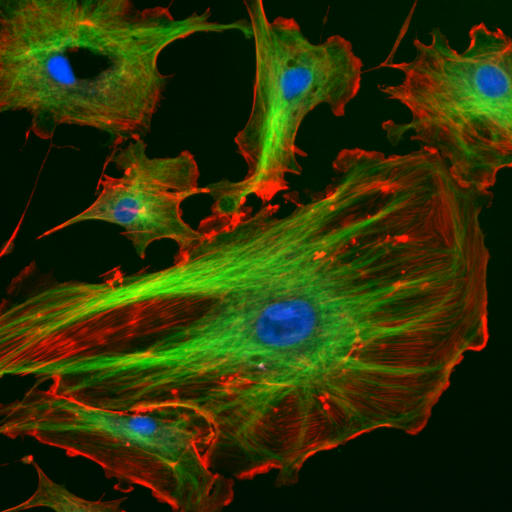Cytoskeleton
Please Take Over This Page and Apply to be Editor-In-Chief for this topic: There can be one or more than one Editor-In-Chief. You may also apply to be an Associate Editor-In-Chief of one of the subtopics below. Please mail us [1] to indicate your interest in serving either as an Editor-In-Chief of the entire topic or as an Associate Editor-In-Chief for a subtopic. Please be sure to attach your CV and or biographical sketch.
Overview

The cytoskeleton is a cellular "scaffolding" or "skeleton" contained, as all other organelles, within the cytoplasm. It is contained in all eukaryotic cells and recent research has shown it can be present in prokaryotic cells too.[1] It is a dynamic structure that maintains cell shape, and also has been known to protect the cell, enables some cell motion (using structures such as flagella and cilia), and plays important roles in both intra-cellular transport (the movement of vesicles and organelles, for example) and cellular division. It is a bone-like structure floating around within the cytoplasm.
The prokaryotic cytoskeleton
The cytoskeleton was previously thought to be a feature only of eukaryotic cells, but homologues to all the major proteins of the eukaryotic cytoskeleton have recently been found in prokaryotes. Although the evolutionary relationships are so distant that they are not obvious from protein sequence comparisons alone, the similarity of their three-dimensional structures provides strong evidence that the eukaryotic and prokaryotic cytoskeletons are truly homologous.
FtsZ
FtsZ was the first protein of the prokaryotic cytoskeleton to be identified. Like tubulin, FtsZ forms filaments in the presence of GTP, but these filaments do not group into tubules. During cell division, FtsZ is the first protein to move to the division site, and is essential for recruiting other proteins that synthesize the new cell wall between the dividing cells.
MreB and ParM
Prokaryotic actin-like proteins, such as MreB, are involved in the maintenance of cell shape. All non-spherical bacteria have genes encoding actin-like proteins, and these proteins form a helical network beneath the cell membrane that guides the proteins involved in cell wall biosynthesis.
Some plasmids encode a partitioning system that involves an actin-like protein ParM. Filaments of ParM exhibit dynamic instability, and may partition plasmid DNA into the dividing daughter cells by a mechanism analogous to that used by microtubules during eukaryotic mitosis.
Crescentin
The bacterium Caulobacter crescentus contains a third protein, crescentin, that is related to the intermediate filaments of eukaryotic cells. Crescentin is also involved in maintaining cell shape, but the mechanism by which it does this is currently unclear.
References
Further reading
- Linda A. Amos and W. Gradshaw Amos, Molecules of the Cytoskeletion, Guilford, ISBN 0-89862-404-5, LoC QP552.C96A46 1991
External links
- Cytoskeleton, Cell Motility and Motors - The Virtual Library of Biochemistry and Cell Biology
- Cytoskeleton database, clinical trials, recent literature, lab registry ...
- Animation of leukocyte adhesion Animation with some great images of actin and microtubule assembly and dynamics.
ar:هيكل خلوي bn:সাইটোকঙ্কাল bg:Цитоскелет ca:Citosquelet cs:Cytoskelet da:Cytoskelet de:Zytoskelett gl:Citoesqueleto ko:세포골격 hr:Citoskeleton it:Citoscheletro he:שלד התא lb:Zytoskelett lt:Citoskeletas nl:Cytoskelet oc:Citoesquelèt sk:Cytoskelet sr:Цитоскелет sh:Citoskelet fi:Solun tukiranka sv:Cellskelett Template:Jb1 Template:WH Template:WS